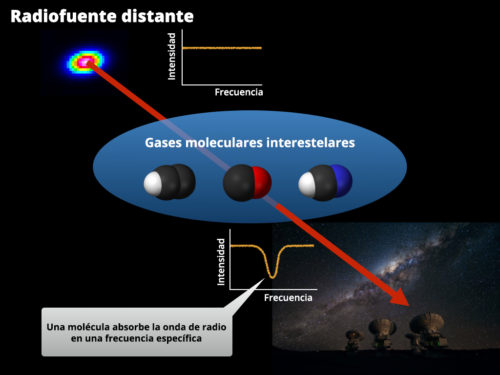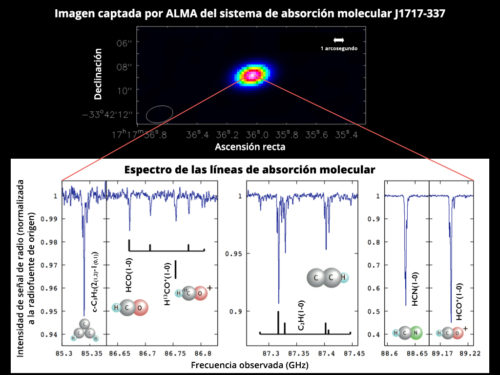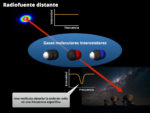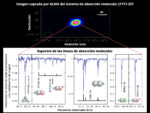ALMA Detects Most Tenuous Molecular Gas Ever Observed
Astronomers using the Atacama Large Millimeter/submillimeter Array (ALMA) discovered the most tenuous molecular gas ever observed. They detected the absorption of radio waves by gas clouds in front of bright celestial objects. This radio shadow revealed the composition and the conditions of diffuse gas in the Milky Way galaxy.
To calibrate its systems, ALMA looks at objects emitting strong radio waves. On rare occasions, the signals from distant calibrator sources have specific radio frequencies absorbed out of them by foreground gas. This process is similar to how a piece of tinted glass casts a colored shadow when light passes through it. These absorption features contain valuable information about the intervening gas clouds that absorb the radio signals. However, the number of known molecular absorption systems seen in millimeter and submillimeter waveband has been very limited: only about 30 in the Milky Way galaxy and a limited number in other galaxies.
To find more absorption systems, a research team including Ryo Ando (a graduate student at the University of Tokyo), Kotaro Kohno (a professor at the University of Tokyo), and Hiroshi Nagai (a project associate professor at the National Astronomical Observatory of Japan) collected the calibration data from the ALMA Data Archive.

Figure 1. Illustration of absorption systems. Calibrator sources have flat radio spectra. Molecules in the intervening gas clouds absorb radio waves at specific frequencies determined by the type of molecules. Credit: R. Ando (The University of Tokyo), ESO/José Francisco Salgado

Figure 2. Radio image (upper) and spectra (bottom) of J1717-337 taken with ALMA. Thanks to its high sensitivity, ALMA detects many absorption lines caused by various molecules such as HCN and HCO+. Credit: ALMA (ESO/NAOJ/NRAO), R. Ando (The University of Tokyo)
By examining data from 36 calibrator sources, the team discovered three new absorption systems and confirmed one previously known system. For one calibrator source, J1717-337, they found absorptions caused by ten different molecules, such as C3H2, CS, and HCS+. In addition, the team found absorption signals caused by HCO molecules for two of the calibrator sources, J1717-337 and NRAO530. The HCO absorption signal is very rare; only three other examples are known in the Milky Way galaxy.
Absorption systems allow researchers to investigate very tenuous gas clouds. A gas cloud too diffuse to emit sufficient radio waves to be detected can still absorb enough radio waves to produce a detectable radio shadow. The team estimated that the amount of HCO in the cloud backlit by NRAO530 is only half that of other known systems. This shows that it is one of the most diffuse gas clouds ever discovered in the Milky Way galaxy. Even though astronomers assume that tenuous gas clouds account for a considerable fraction of the total mass of the Milky Way galaxy, very little is known about them.
The absorption signals help us determine the environment around the foreground gas clouds. HCO molecules are thought to be formed in special environments full of intense ultraviolet light from giant young stars. The diffuse gas clouds backlit by J1717-337 and NRAO530 show chemical composition similar to the gas in active star forming regions, indicating that the diffuse gas is bathed in strong ultraviolet light. Astronomers believe that ultraviolet light affects the properties of diffuse clouds. The HCO absorption systems found by ALMA provide an opportunity to verify that idea.
This research revaluates the importance of the ALMA calibration data. Usually the calibration data are considered supplementary, but this research shows that the calibration data themselves may contain significant scientific discoveries. The data for the more than 1000 calibration sources stored in the ALMA Data Archive are publicly available, and ALMA continues to take calibration data as part of normal observations. For astronomers, the Archive is a gold mine with the potential to yield more absorption systems or other unexpected mysteries of the Universe.
This observation result was published as Ando et al. “New detections of Galactic molecular absorption systems toward ALMA calibrator sources” in the Publications of the Astronomical Society of Japan, issued in December 2015.
Additional information
The Atacama Large Millimeter/submillimeter Array (ALMA), an international astronomy facility, is a partnership of the European Organisation for Astronomical Research in the Southern Hemisphere (ESO), the U.S. National Science Foundation (NSF) and the National Institutes of Natural Sciences (NINS) of Japan in cooperation with the Republic of Chile. ALMA is funded by ESO on behalf of its Member States, by NSF in cooperation with the National Research Council of Canada (NRC) and the Ministry of Science and Technology (MOST) in Taiwan and by NINS in cooperation with the Academia Sinica (AS) in Taiwan and the Korea Astronomy and Space Science Institute (KASI).
ALMA construction and operations are led by ESO on behalf of its Member States; by the National Radio Astronomy Observatory (NRAO), managed by Associated Universities, Inc. (AUI), on behalf of North America; and by the National Astronomical Observatory of Japan (NAOJ) on behalf of East Asia. The Joint ALMA Observatory (JAO) provides the unified leadership and management of the construction, commissioning and operation of ALMA.
Links
Contacts
Valeria Foncea
Education and Public Outreach Officer
Joint ALMA Observatory
Santiago, Chile
Tel: +56 2 467 6258
Cell: +56 9 75871963
Email: [email protected]
Masaaki Hiramatsu
Education and Public Outreach Officer, NAOJ Chile
Observatory
Tokyo, Japan
Tel: +81 422 34 3630
E-mail: [email protected]
Richard Hook
Public Information Officer, ESO
Garching bei München, Germany
Tel: +49 89 3200 6655
Cell: +49 151 1537 3591
Email: [email protected]
Charles E. Blue
Public Information Officer
National Radio Astronomy Observatory
Charlottesville, Virginia, USA
Tel: +1 434 296 0314
Cell: +1 434.242.9559
E-mail: [email protected]


